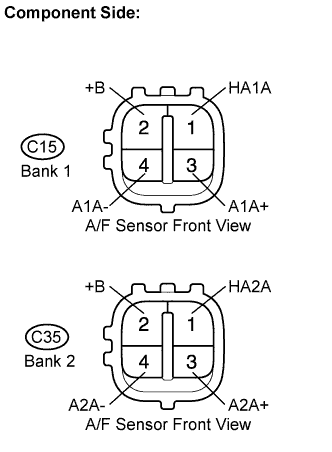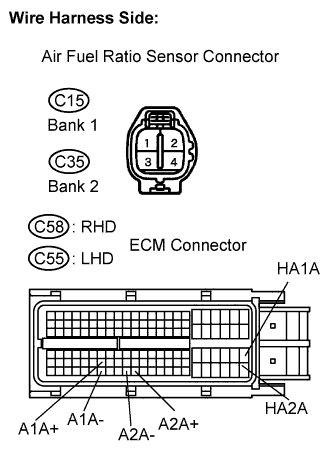DTC P2A00 A/F Sensor Circuit Slow Response (Bank 1 Sensor 1) |
DTC P2A03 A/F Sensor Circuit Slow Response (Bank 2 Sensor 1) |
for Preparation Click here
DESCRIPTION
- HINT:
- DTC P2A00 indicates malfunctions related to the bank 1 A/F sensor.
- DTC P2A03 indicates malfunctions related to the bank 2 A/F sensor.
- Bank 1 refers to the bank that includes cylinder No. 1.
- Bank 2 refers to the bank that includes cylinder No. 2.
- Sensor 1 refers to the sensor mounted in front of the Three-Way Catalytic Converter (TWC) and located near the engine assembly.
- Although the DTC titles say oxygen sensor, these DTCs relate to the Air-Fuel Ratio (A/F) sensor.
- Sensor 1 refers to the sensor mounted in front of the Three-Way Catalytic Converter (TWC) and located near the engine assembly.
The A/F sensor is the planar type and is integrated with the heater, which heats the solid electrolyte (zirconia element). This heater is controlled by the ECM. When the intake air volume is low (the exhaust gas temperature is low), a current flows into the heater to heat the sensor, in order to facilitate accurate oxygen concentration detection. In addition, the sensor and heater portions are narrower than the conventional type. The heat generated by the heater is conducted to the solid electrolyte through the alumina, therefore the sensor activation is accelerated.
A three-way catalytic converter (TWC) is used in order to convert the carbon monoxide (CO), hydrocarbon (HC), and nitrogen oxide (NOx) into less harmful substances. To allow the TWC to function effectively, it is necessary to keep the air-fuel ratio of the engine near the stoichiometric air-fuel ratio.
*: Value changes inside the ECM. Since the A/F sensor is the current output element, a current is converted to a voltage inside the ECM. Any measurements taken at the A/F sensor or ECM connectors will show a constant voltage.

| DTC No. | DTC Detection Conditions | Trouble Area |
| P2A00 P2A03 | Calculated value for air-fuel ratio (A/F) sensor response rate deterioration level is less than threshold |
|
CONFIRMATION DRIVING PATTERN
- HINT:
- Performing this confirmation pattern will activate the A/F sensor response monitor.

- Connect an intelligent tester to the DLC3.
- Turn the ignition switch to the ON position.
- Turn the tester on.
- Clear the DTCs (where set).
- Start the engine and warm it up (Procedure "A").
- Drive the vehicle at between 40 km/h and 120 km/h (25 mph and 75 mph) for 3 minutes. However, the vehicle should be driven at a constant speed (Procedure "B").
- Select the following menu items: Powertrain / Engine / DTC.
- Check if any DTCs (any pending DTCs) are set.
WIRING DIAGRAM
Refer to DTC P2195 (Click here).INSPECTION PROCEDURE
- HINT:
- Intelligent tester only:
- Malfunctioning areas can be identified by performing "Control the Injection Volume for A/F Sensor" provided in the Active Test . "Control the Injection Volume for A/F Sensor" can help to determine whether the Air-fuel Ratio (A/F) sensor, Heated Oxygen (HO2) sensor and other potential trouble areas are malfunctioning.
- Connect the intelligent tester to the DLC3.
- Start the engine and turn the tester on.
- Warm up the engine at an engine speed of 2,500 rpm for approximately 90 seconds.
- On the intelligent tester, enter the following menus: Powertrain / Engine / Active Test / Control the Injection Volume for A/F Sensor.
- Perform "Control the Injection Volume for A/F Sensor" with the engine in an idling condition (press the RIGHT or LEFT button to change the fuel injection volume).
- Monitor the output voltages of the A/F and HO2 sensors (AFS B1 S1 and O2S B1 S2 or AFS B2 S1 and O2S B2 S2) displayed on the tester.
- HINT:
- "Control the Injection Volume for A/F Sensor" operation lowers the fuel injection volume by 12.5 % or increases the injection volume by 25 %.
- Each sensor reacts in accordance with increases in the fuel injection volume.
| Tester Display (Sensor) | Injection Volume | Status | Voltage |
| AFS B1 S1 or AFS B2 S1 (A/F) | +25 % | Rich | Less than 3.0 V |
| AFS B1 S1 or AFS B2 S1 (A/F) | -12.5 % | Lean | More than 3.35 V |
| O2S B1 S2 or O2S B2 S2 (HO2) | +25 % | Rich | More than 0.55 V |
| O2S B1 S2 or O2S B2 S2 (HO2) | -12.5 % | Lean | Less than 0.4 V |
- NOTICE:
- The Air-Fuel Ratio (A/F) sensor has an output delay of a few seconds and the Heated Oxygen (HO2) sensor has a maximum output delay of approximately 20 seconds.
| Case | A/F Sensor (Sensor 1) Output Voltage | HO2 Sensor (Sensor 2) Output Voltage | Main Suspected Trouble Area | ||
| 1 | Injection Volume +25 % -12.5 % |  | Injection Volume +25 % -12.5 % |  | - |
| Output Voltage More than 3.35 V Less than 3.0 V |  | Output Voltage More than 0.55 V Less than 0.4 V |  | ||
| 2 | Injection Volume +25 % -12.5 % |  | Injection Volume +25 % -12.5 % |  |
|
| Output Voltage Almost no reaction |  | Output Voltage More than 0.55 V Less than 0.4 V |  | ||
| 3 | Injection Volume +25 % -12.5 % |  | Injection Volume +25 % -12.5 % |  |
|
| Output Voltage More than 3.35 V Less than 3.0 V |  | Output Voltage Almost no reaction |  | ||
| 4 | Injection Volume +25 % -12.5 % |  | Injection Volume +25 % -12.5 % |  |
|
| Output Voltage Almost no reaction |  | Output Voltage Almost no reaction |  | ||
- Performing "Control the Injection Volume for A/F Sensor" enables technicians to check and graph the voltage outputs of both the A/F and HO2 sensors.
- The following A/F Control procedure enables the technician to check and graph the voltage output of both the heated oxygen sensors. To display the graph, select the following menu items on the tester: View / Line Graph.
- HINT:
- DTC P2A00 or P2A03 may also be set when the air-fuel ratio remains rich or lean.
- A low A/F sensor voltage could be caused by a rich air-fuel mixture. Check for conditions that would cause the engine to run rich.
- A high A/F sensor voltage could be caused by a lean air-fuel mixture. Check for conditions that would cause the engine to run lean.
- Read freeze frame data using the intelligent tester. The ECM records vehicle and driving condition information as freeze frame data the moment a DTC is stored. When troubleshooting, freeze frame data can be helpful in determining whether the vehicle was running or stopped, whether the engine was warmed up or not, whether the air-fuel ratio was lean or rich, as well as other data recorded at the time of a malfunction (Click here).
| 1.CHECK ANY OTHER DTCS OUTPUT (IN ADDITION TO DTC P2A00 AND/OR P2A03) |
Connect the intelligent tester to the DLC3.
Turn the ignition switch to the ON position.
Turn the tester on.
Enter the following menus: Powertrain / Engine / DTC.
Read the DTCs.
- Result:
Display (DTC Output) Proceed to P2A00 and/or P2A03 A P2A00 and/or P2A03 and other DTCs B
- HINT:
- If any DTCs other than P2A00 or P2A03 are output, troubleshoot those DTCs first.
|
| ||||
| A | |
| 2.INSPECT AIR FUEL RATIO SENSOR (HEATER RESISTANCE) |
 |
Disconnect the C15 or C35 A/F sensor connector.
Measure the resistance according to the value(s) in the table below.
- Standard resistance:
- Bank 1 sensor 1:
Tester Connection Condition Specified Condition HA1A (1) - +B (2) 20°C (68°F) 1.8 to 3.4 Ω HA1A (1) - A1A- (4) - 10 kΩ or higher - Bank 2 sensor 1:
Tester Connection Condition Specified Condition HA2A (1) - +B (2) 20°C (68°F) 1.8 to 3.4 Ω HA2A (1) - A2A- (4) - 10 kΩ or higher
Reconnect the A/F sensor connector.
|
| ||||
| OK | |
| 3.CHECK HARNESS AND CONNECTOR (A/F SENSOR - ECM) |
Disconnect the C15 and C35 A/F sensor connectors.
 |
Turn the ignition switch to the ON position.
Measure the voltage according to the value(s) in the table below.
- Standard voltage:
Tester Connection Specified Condition +B (C15-2) - Body ground 9 to 14 V +B (C35-2) - Body ground 9 to 14 V
Turn the ignition switch off.
Disconnect the C58 (RHD) or C55 (LHD) ECM connector.
Measure the resistance according to the value(s) in the table below.
- Standard resistance (Check for open):
- RHD:
Tester Connection Specified Condition HA1A (C15-1) - HA1A (C58-86) Below 1 Ω A1A+ (C15-3) - A1A+ (C58-93) Below 1 Ω A1A- (C15-4) - A1A- (C58-116) Below 1 Ω HA2A (C35-1) - HA2A (C58-109) Below 1 Ω A2A+ (C35-3) - A2A+ (C58-120) Below 1 Ω A2A- (C35-4) - A2A- (C58-119) Below 1 Ω - LHD:
Tester Connections Specified Condition HA1A (C15-1) - HA1A (C55-86) Below 1 Ω A1A+ (C15-3) - A1A+ (C55-93) Below 1 Ω A1A- (C15-4) - A1A- (C55-116) Below 1 Ω HA2A (C35-1) - HA2A (C55-109) Below 1 Ω A2A+ (C35-3) - A2A+ (C55-120) Below 1 Ω A2A- (C35-4) - A2A- (C55-119) Below 1 Ω
- Standard resistance (Check for open):
- RHD:
Tester Connection Specified Condition HA1A (C15-1) or HA1A (C58-86) - Body ground 10 kΩ or higher A1A+ (C15-3) or A1A+ (C58-93) - Body ground 10 kΩ or higher A1A- (C15-4) or A1A- (C58-116) - Body ground 10 kΩ or higher HA2A (C35-1) or HA2A (C58-109) - Body ground 10 kΩ or higher A2A+ (C35-3) or A2A+ (C58-120) - Body ground 10 kΩ or higher A2A- (C35-4) or A2A- (C58-119)- Body ground 10 kΩ or higher - LHD:
Tester Connection Specified Condition HA1A (C15-1) or HA1A (C55-86) - Body ground 10 kΩ or higher A1A+ (C15-3) or A1A+ (C55-93) - Body ground 10 kΩ or higher A1A- (C15-4) or A1A- (C55-116) - Body ground 10 kΩ or higher HA2A (C35-1) or HA2A (C55-109) - Body ground 10 kΩ or higher A2A+ (C35-3) or A2A+ (C55-120) - Body ground 10 kΩ or higher A2A- (C35-4) or A2A- (C55-119) - Body ground 10 kΩ or higher
Reconnect the ECM connector.
Reconnect the A/F sensor connector.
|
| ||||
| OK | |
| 4.PERFORM CONFIRMATION DRIVING PATTERN |
| NEXT | |
| 5.CHECK WHETHER DTC OUTPUT RECURS (DTC P2A00 AND/OR P2A03) |
Read the DTCs using the intelligent tester.
Enter the following menus: Powertrain / Engine / DTC.
- Result:
Display (DTC Output) Proceed to P2A00 and/or P2A03 A No output B
|
| ||||
| A | |
| 6.REPLACE AIR FUEL RATIO SENSOR |
Replace the air fuel ratio sensor (Click here).
| NEXT | |
| 7.PERFORM CONFIRMATION DRIVING PATTERN |
| NEXT | |
| 8.CHECK WHETHER DTC OUTPUT RECURS (DTC P2A00 AND/OR P2A03) |
Read the DTCs using the intelligent tester.
Enter the following menus: Powertrain / Engine / DTC.
- Result:
Display (DTC Output) Proceed to No output A P2A00 and/or P2A03 B
|
| ||||
| A | ||
| ||
